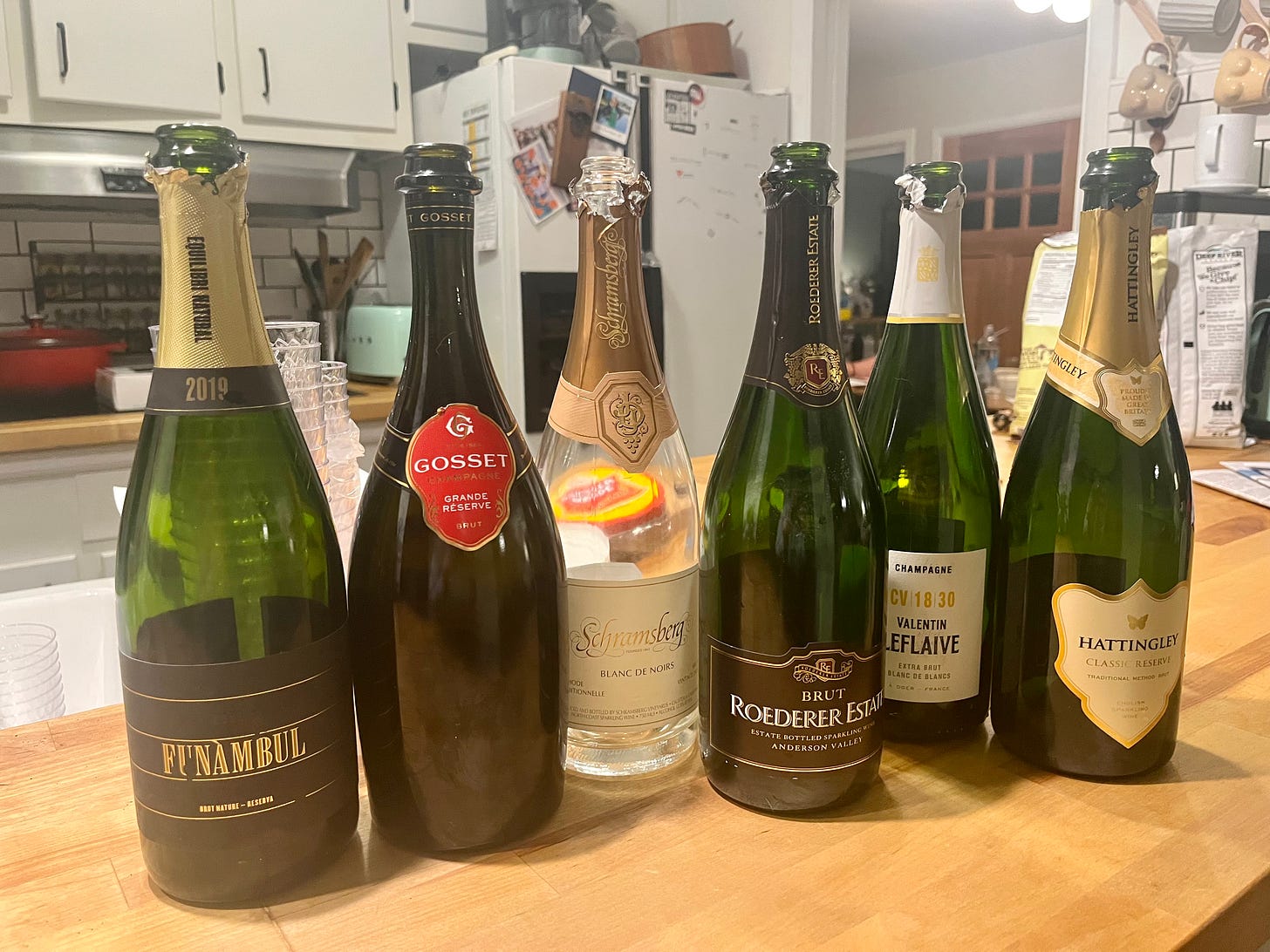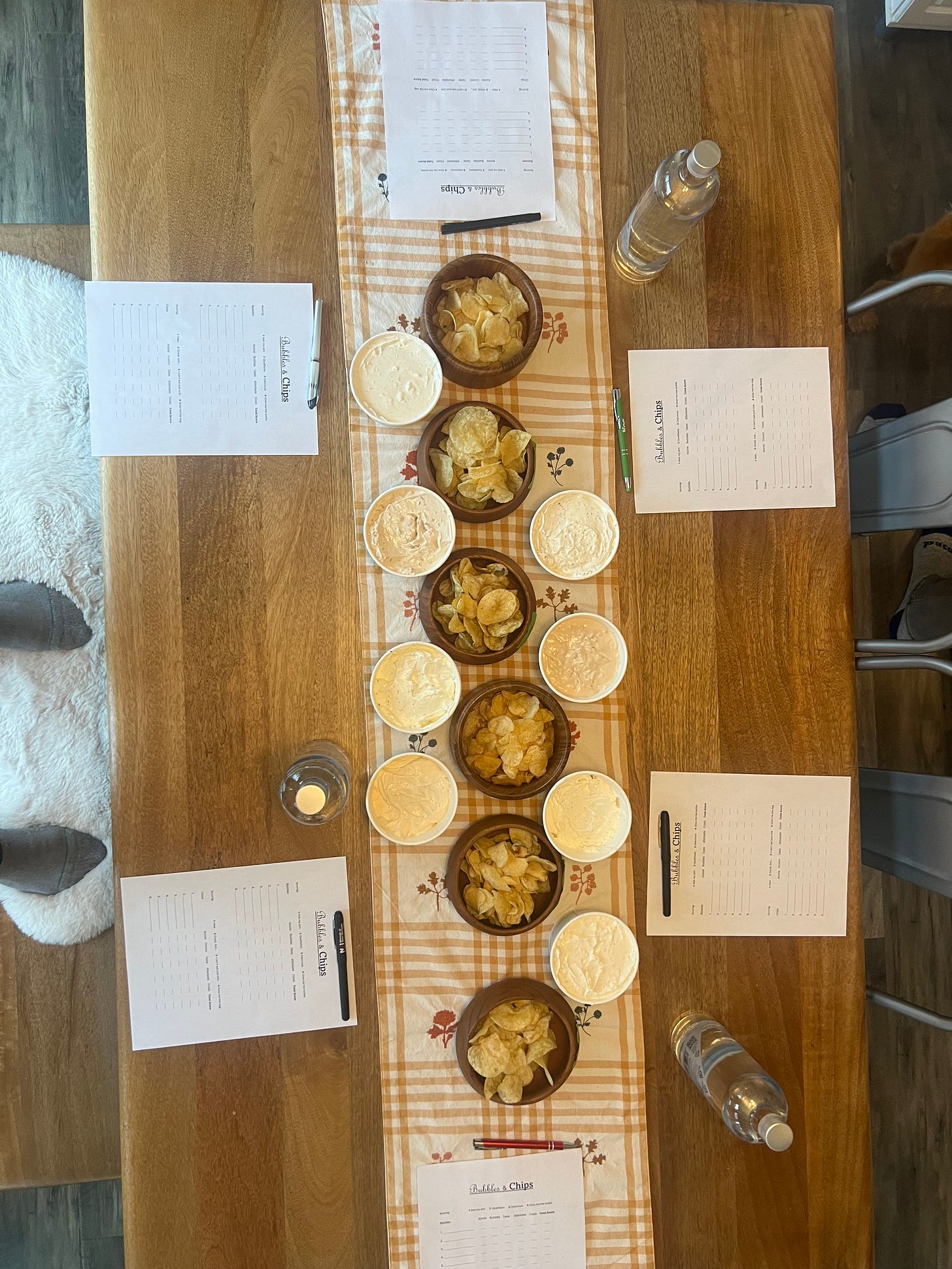OK, so it wasn’t comprehensive or very scientific, but the journey to taste various sparkling wines was a hoot.
We gathered Sunday afternoon with my sister, Hillary, her beau Ed, and friends Mike and Molly. Mike is a wine rep and was gracious enough to round up six various sparkling wines made in the traditional Champagne method. That means the wine goes through normal fermentation before being bottled, then undergoes a second fermentation in the bottle with added yeast and sugar, which leads to the bubbles.
To pair with them, we blind-tasted six different types of kettle chips, as well as eight onion dips. The results were really fun!
(Thanks for entertaining the real Saturday Sips edition on a Monday!)
The Bubbles
Mike brought six bottles of sparkling wines:
Champagne Valentin Laflave Extra Brut, a Blanc de Blanc from France that appears to retail between $50 and $65, depending on where you look. It is made with Chardonnay grapes.
Roederer Estate Brut, a California sparkler that retails for approximately $30. Mike called it a very middle-ground wine, so it is a good selection for restaurants to carry. Made with Pinot Noir and Chardonnay grapes.
Hattingly Classic Reserve is a sparkling wine from England made with Chardonnay, Pinot Noir, and Pinor Meunier. As a relatively new operator, it is fairly hard to acquire but appears to retail for around $35-$50.
Schramsberg Blanc de Noirs, another California maker — since 1862 — made with Pinot Noir and Chardonnay. It’s available for under $40.
Gosset Grand Reserve, declared on its label the oldest wine house in Champagne, with an established date of 1584. It uses Chardonnay, Pinot Noir and Pinor Meunier. You could find a bottle for $50.
Funambul, a Cava from Spain. It’s made with Xarel.lo, Macabeo and Parellada grapes.
The Bubbles Scores, with interesting notes:
The six of us used Mike’s very official scoring sheet where you could rate from 1 to 4 in five categories. That provided a maximum score of 120.
Scores: 1 = Not my Jam; 2 = Quaffable; 3 = Delicious; 4 = Give me the bottle.
Categories: Aroma, Bubbles, Taste, Aftertaste, Finish
The tasting was a true demonstration of personal preference. And to be sure, our categories were out of wack because of the glassware we used, which certainly affected the aroma and the whole olfactory experience.
Also, the fourth score of “Give me the Bottle” is misleading, because if any of these bottles showed up at a celebration, they’d all be happily drunk.
Gosset topped the tasting with a score of 87, it was the most pleasing on the nose for pretty much everyone and hit the taste buds delightfully.
Champagne Valentin and Schramsburg tied for second. While Valentin was pretty equally distributed — especially from Hillary, who normally dislikes Blanc de Blancs — Schramsburg was the favorite of two panelists, Molly and Alyssa, while scoring extremely low for Hillary.
Hattingly came in third, hitting 73, which does fit Tristan’s comment to me about hoq the growing climate suits England well now. It took some significant hits from the aroma, which did give off quite a bit of barnyard funk, but otherwise scored well, particularly in taste.
Roederer Estate and Tunambul both clocked in at 66. Certainly drinkable, but the pair lacked a lot in most categories in comparison to the top four.
I guess the lesson here is that the French still know best, but other regions producing Champagne Method are still worth consideration if you’re looking for bubbles. There were certainly more brands we could have tried and perhaps should have included, but six seemed a solid and well-rounded sample size.
The Chips
An even less scientific test, we based scores on aroma, crunch, taste and after-taste. Kettle chips are definitely a must to accompany sparkling wine and they all were terrific, for the most part.
The brands:
Cape Cod
Our Family (a local store brand)
Great Lakes
Lays Kettle
Deep River
Kettle Brand
The ranking:
Great Lakes was the clear favorite, clocking in a score of 77.
Lays Kettle jumped in at 67.
Kettle Brand put up a 65.
Cape Cod and Deep River both scored 60.
Our Family was a lowly 47.
The Dips
Ed and Hillary over-delivered with the dips, bringing eight. As a dip agnostic, I had no idea there were so many types of French Onion dips. This was even less scientific than the chips, it’s really hard to try a lot of heavy onion and make it make sense.
We just had everyone rank them 1 through 4.
The results:
Lipton Onion Soup and Dip Mix — 21 (out of a possible 24!), which seems amazing for the one they had to make by hand.
Country Fresh and Sobie — The pair tied with 17, interesting because one is a classic store-bought familiar white dip, while Sobie, a Grand Rapids deli, makes the dip that has a nice brown coloration to it.
Lay’s — 14, a fun one for the dip found in the unrefrigerated chip aisle.
Meijer and Heluva Good — They tied at 12 with no overwhelming notes.
Daisy — A dollop of daisy onion dip scored 11.
Dean’s — Another seemingly classic trailed everyone else at 9, it was relatively flavorless and a bit watery.





